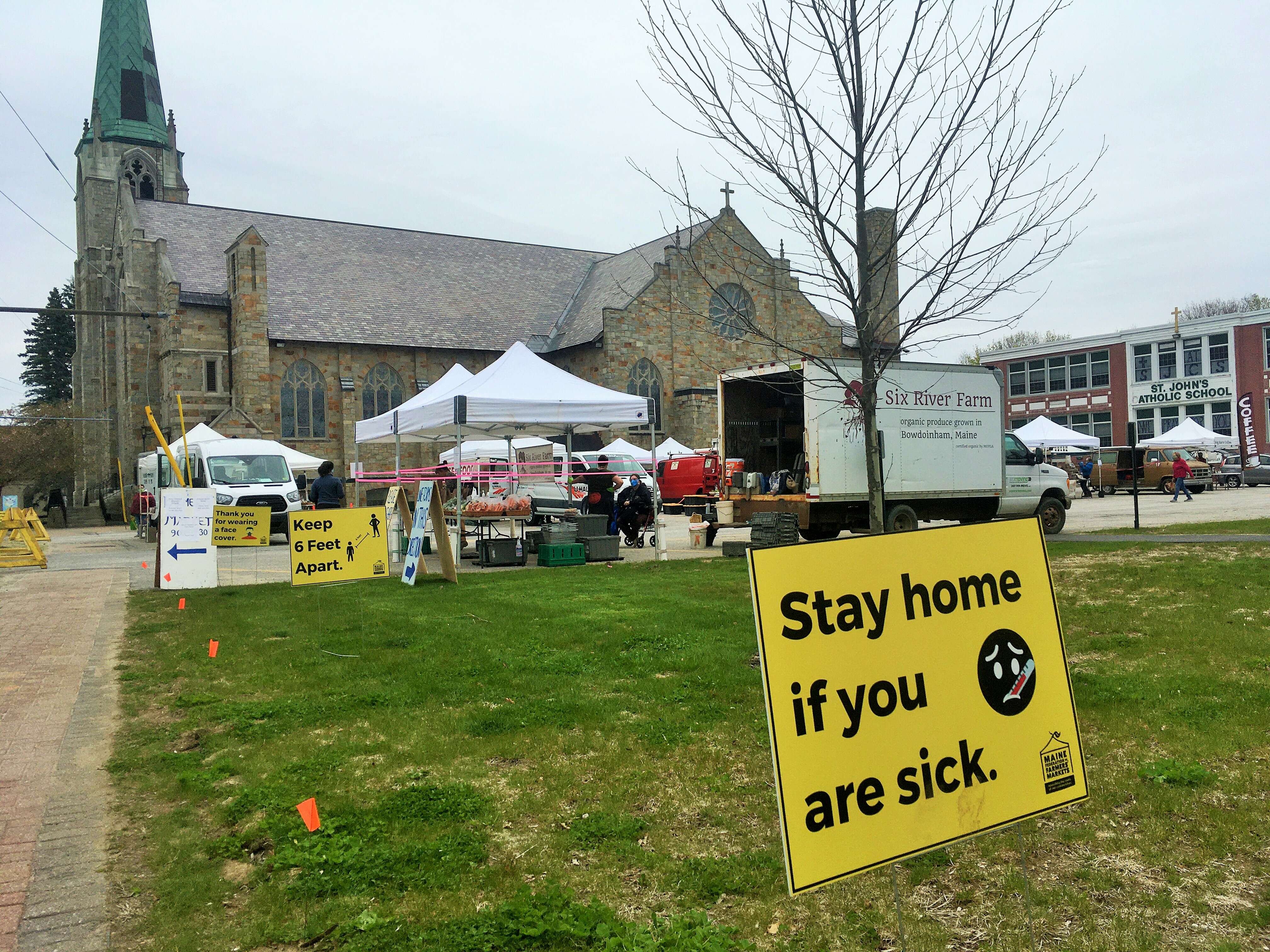
Amid pandemic, Maine farmers markets are busier than ever
With new business likely spurred by the pandemic, farmers markets throughout Maine are busier than they’ve ever been.
The information is anecdotal, but Jimmy DeBiasi, director of programs at the Maine Federation of Farmers' Markets, said most markets are reporting that, for this time of year, they’re seeing an increase in shopper traffic.
“I heard today from the Auburn farmers market, where vendors are saying that, in the second week of operation, they’ve had their best sales they’ve ever had in its history,” he said.
That might be because people perceive outdoor markets as safer places to shop than indoor environments, he said.
“It doesn’t hurt that the weather has been really nice on some of these days, too,” he added.
An uptick in patronage was also seen at the winter markets that were operating when the pandemic started. Some farmers were selling out their products, he said.
There’s also an increased incidence of new shoppers, which seems to be demonstrated in online pre-orders. Increasing numbers of farms have updated their websites since the start of the pandemic to offer e-commerce platforms listing inventory and taking orders. People can pre-order on an individual farm’s website then pick up their pre-packaged order at the market, which minimizes contact. DeBiasi said he heard from one farm that last month sold out of greens within 30 minutes when it launched its e-commerce platform.
The pre-order avenue continues to evolve, however.
“Farmers now are hitting a wall,” he said. “They don’t want to spend hours the evening before a market packing pre-orders when normally they’re harvesting for the market. So farmers are now trying to seek a balance. Some are transitioning to pre-orders only being available to people who identify as being high risk for COVID-19. Others are just trying to improve the efficiencies of online ordering.”
Overall, he said, vendors and shoppers are becoming accustomed to the new normal at the markets.
They're now being set up under guidelines issued in late March by the Maine Department of Agriculture, Conservation and Forestry for farmers across the state marketing directly to consumers. The guidelines strongly encourage markets to adjust physical layouts to promote social distancing, including one-way pedestrian traffic, special shopping times for seniors and people with compromised health, use of paperless payment options and an online pre-order and pick-up system, sending only one shopper per household, face masks and hand washing or sanitizing, and signage and staff to alert shoppers to safety measures.
The federation has been coordinating with market managers to translate best practices into action, troubleshoot challenges, and develop market signage and other resources. Market managers have been working many extra hours to organize their markets under the new guidelines, DeBiasi said.
Customers can expect a different environment at the markets, which have adjusted their vendor booth layouts so they’re spaced further apart. At some markets, like the Bridgton Farmers’ Market, shopper flow will move in one-way directions to avoid bottlenecks and assist in maintaining a safe physical distance. Many farmers are accepting online orders, to limit the shopping time at market. Farmers are bagging and pricing more products in advance, rather than having their customers purchase loose products by the pound.

“We've got three Portland summer markets under our belt now and it's going very well,” Carolyn Snell of Snell Family Farms said in a news release. “We have one-way flow and it really helps. People are following it more and more at each market. As a vendor it feels so much more calm than the old days, honestly, to have a unified flow.”
The markets and their vendors have adapted well, DeBiasi noted.
“They were very quick to respond,” he said.
Farmers markets no longer host musicians, and many are not allowing craft vendors, he said.
“It’s still a chance to go out and say hi to people and talk, but only in short bursts,” he said. “The norm now is to go about your business and carry on. I think many shoppers are just maintaining the integrity of the situation by virtue of following the rules closely and making it as comfortable as possible for everybody.”
About 12 winter farmers markets were underway when the pandemic hit, he said.
“The winter markets kind of got to test the waters first and provide feedback when the pre-orders started happening,” he said.
One winter market, in Bridgton, shifted to pre-orders only with drive-through pick-up.
“You’d come and say your name, and the farmers would grab your box of food and give it to you,” he said. “It was good to have this gradual transition and figure out best practices.”
The spring season started early to mid-May for most markets. A handful started in late April. Nearly the full complement of more than 120 summer markets is open now, he said.
“The markets are opening up on schedule,” he said.
It’s hard to say yet whether the same number of vendors will be on hand, although some farms decided early on that they weren’t going to be at the markets this year, he said.
Because of distancing guidelines between vendors, some markets have changed or expanded their locations. The Belfast market was able to spread out to a lawn that’s behind their typical parking lot venue. A market in Brunswick moved to a high school parking lot, where vendors can spread out and where it’s easier to monitor traffic and limit the number of shoppers. A market in Portland has spaced out its vendors along a quarter-mile walk.
Other markets have limited room to spread out. Ellsworth’s is held in a parking lot bounded by buildings.
“They’ll be relocating some vendors to new areas, but they just have limited room to grow,” he said.
On the product side, vendors are reporting that seedling sales are through the roof, said DeBiasi. There’s also some discussion among farmers of increasing plantings of root and other storage crops for future sales, he added.
A number of markets also report that Supplemental Nutrition Assistant Program (SNAP) sales are up, he said. The foundation expects a surge in shoppers using SNAP at farmers’ markets this year due the increased enrollment in SNAP that is underway as a result of the pandemic.
Through the Maine Harvest Bucks program, more than 30 farmers’ markets offer bonus bucks to shoppers using SNAP/EBT. There are other programs at farmers’ markets that help people in need. Many markets have vendors who accept WIC Farmers’ Market checks and participate in the Maine Senior FarmShare Program. Additionally, there are gleaning groups that bring tons of fresh produce from markets to food pantries each year.
More than 120 summer farmers’ markets provide fresh food access to customers and a means of livelihood to more than 2,000 farmers and local food businesses.
To find out where farmers’ markets are located this year, click here.
Markets can be found by day of the week or ZIP code. Markets can also be found through their Facebook pages and websites, which provide information on changes to their market schedule or location.
In March, Gov. Janet Mills deemed as essential most agriculture businesses related to farming.
Maine has more than 8,000 working farms, with $3.8 billion in sales and 24,000 jobs, according to the most recent U.S. Department of Agriculture figures.










0 Comments